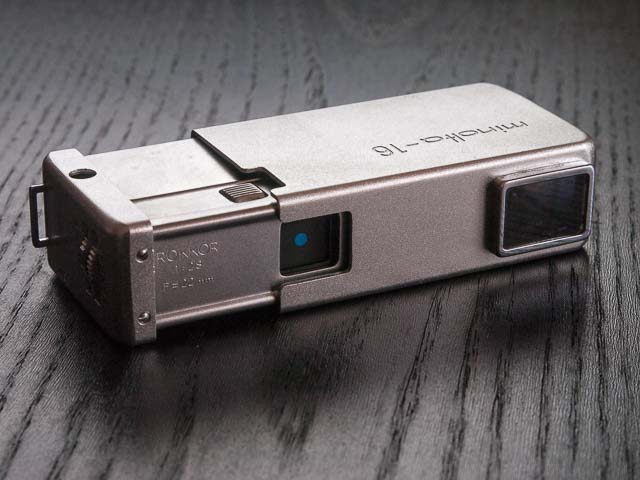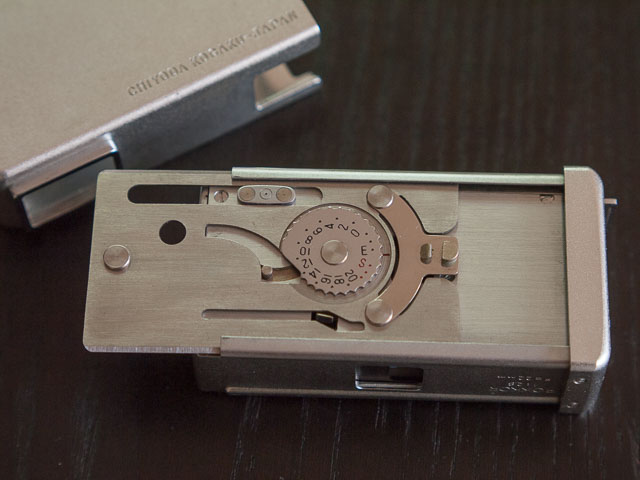Minolta-16II

Minolta had a long history of making 16mm sub-miniature cameras. The Minolta 16mm story goes back to 1947 and the Konan 16 Automat, made by the Konan Institute. Minolta took over the Konan Institute and produced its own version, the Minolta 16 Automat in 1955. The main difference between the Minolta and the earlier Konan was a new film cassette. The Minolta 16mm film cassette became the nearest thing sub-miniature cameras would ever get to a standard film cassettes.
Like it's Konan forebear, the Minolta 16 Automat used a telescopic body style that was very compact. Minolta continued to produce cameras with basically the same body right up to the point when they stopped making 16mm cameras in 1974. But they also produced a wide range of other 16mm cameras with a variety of body styles and at a variety price points. This wide range of cameras can be a bit confusing as many different types were available at any point in time.
The original telescopic design was introduced in 1955 and produced right through to 1974. The 16 Automat was replaced by the 16I in 1957, adding the ability to use a range of filters and close up attachments. In 1960 the 16I was replaced the 16II adding a wider range of shutter speeds and apertures to the mix. This is the model featured on this page. The 16I and 16II models were available in a range of colours in addition to the common silver models, including black, gold, blue, red, magenta and green. In 1972 the 16II cost £19.55 camera only, or £26.95 including a flash and accessory kit. (The price information on these pages came from a scan I found online of the ‘UK Camera Guide 1972’ on the web. Unfortunately the webpages with the scans is no longer available.)
In 1960 Minolta introduced a second line simpler cheaper cameras with the 16P, which had a single shutter speed and weather symbol exposure control. This was replaced in 1965 by the 16Ps which was identical except for the addition of a leaver on the front which allowed for the selection of a second shutter speed, primarily for flash operation. It was even marked the 16P, but it can be distinguished by the lever. In 1972 the 16Ps cost £13.95 camera only, or £19.95 including a flash kit.
In 1962 Minolta introduced a third line, and their first 16mm camera with a built-in selenium cell exposure meter, with the 16EE model. The 16EE was based on a similar form factor to the 16P. In 1963 the 16EE was replaced by the 16EE2. The EE line was pretty short lived… the 16EE2 was discontinued in 1965.
In 1966 a forth luxury line was introduced in the form of the 16MG. In my opinion the 16MG is by for the prettiest of the whole Minolta 16mm line. This camera is mentioned in the UK Camera Guide 1972, though some sources say is was only made until 1971. In 1972 the 16MG cost £38.95 camera only, or £44.95 including a flash kit. In 1970 the 16MG was joined by the top of the line 16MGS. This introduced a range of innovations, the main one being a larger negative size. By moving from double perforated film to single perforated film space was found to increase the negative area from 10x14mm to 12x17mm. In 1972 the 16MGS cost from £65.95 camera only to £146.95 including a comprehensive accessory kit.
In 1972 the last of the line was introduced, the 16QT. This camera was based on the 16MGS form factor, and produced the same 12x17mm negatives, but with a reduced specification. It did introduce some new features however. For example it was the first (and only) Minolta 16mm camera to have a focusing lens with four settings. Previous cameras had fixed focus lenses which relied on depth-of-field to get everything in focus from about 9 feet to infinity. Close-up lenses were used for subjects closer than 9 feet away. In 1972 the 16QT cost £39.95 camera only, or £45.95 including a flash kit.
The following timeline shows the models and when they were produced:

16mm cameras could be considered the predecessors of the 110 cameras introduced by Kodak in 1972. Like 110 film, the film used by these cameras is basically 16mm movie film in special cassettes. Minolta stopped selling 16mm cassettes at the beginning of the 90s, but if you are dedicated enough you can buy a device to trim 35mm film down to 16mm which you can then load Minolta cassettes with yourself.
A few years ago, when my camera collection was mainly focused on subminiature cameras, I had a 16 I, a 16Ps and a 16MG. But they were all sold when I slimmed my camera collection down to just my Olympus Pen FT.
But I recently added a Minolta 16mm camera back to my collection in the form of this lovely little Minolta 16 II. This camera really is tiny, but the all metal construction makes it feel surprisingly heavy at 158 grams. It has a 1/30-1/500 (+ B) shutter speed range, an f/2.8-16 aperture range and a fixed -focus 22mm lens. The wide depth-of-field mean that everything from 2.25 meters to infinity is in focus if you set the aperture to f/8. 2 close-up attachments got you as close as 50cm at the same aperture.
This camera was in production with only minor modification for an amazing 17 years! (25 if you include the Konan Automat.)

This is the camera in it’s open position. The shutter is in front of the lens and the blue dot means the film is wound on and you’re ready to take a picture.
You wind the camera on just by opening and closing the camera.

The shutter speed and aperture dials are on one end of the camera.

This is the back of the camera.

This is the underside of the camera. You can see the exposure counter and the catch to open the camera to load it with film.

When you release a catch part of the camera comes off completely revealing the exposure counter and film winding mechanism.

And when you flip the camera back over you see the lid to the film chamber.

Here you can see the film chamber with an empty film canister removed.


